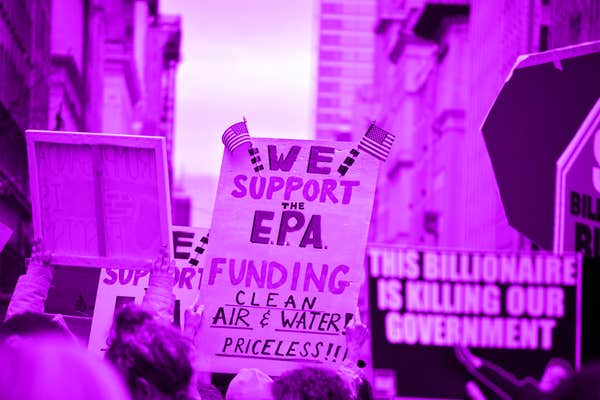
May 5th, 2025
Hey team, and welcome back to one5c! I’ve been feeling something different the last couple weeks. I can’t quite put my finger on it, but it’s kinda a loopy, woozy excitement. Maybe it’s allergies (what the heck with the pollen right now?!), or maybe it’s that I’ve been absorbing the energy from this community and how engaged so many of you are in making the changes that add up to big differences. It’s probably both. Regardless, the vibes are vibing, and I love it.
Also, ICYMI, we just launched our Premium Membership. This newsletter will always be free, but becoming a member gets you some pretty great extras, like a heaping discount on Cool Beans, totally ad-free newsletters, and direct access to the editors for all your burning climate-minded queries. Check out all the benefits and details here. Thank you so much for the support! —Corinne
WHAT WE’RE INTO THIS WEEK
By Sara Kiley Watson

Action alert
100 days and counting…
Last Wednesday marked the end of the first 100 days of President Donald Trump’s second term. In that time, we’ve seen 145 actions that “repeal or weaken environmental rules and escalate the use of planet-heating fossil fuels,” according to a count from The Guardian. The administration has opened up the Pacific Ocean’s seabed and the Arctic to mining and drilling, reinvigorated a sputtering coal industry, opened up forests to logging, and trashed clean air rules. For the climate-conscious, the onslaught is devastating, but it also underscores that our actions matter now more than ever. There truly is something we can do every day to protect the planet and one another: talk about climate change (even when it’s hard), protest or boycott when possible, eat less meat, and resist the urge to buy. It’s also important that we can take care of ourselves and each other when doom starts to creep in.
Planet home
Some great news about a smiley amphibian
A glimmer of hope can do us a lot of good, so here’s a quick dopamine hit: The Mexican axolotl—a rare, adorable, perpetually soft-smiling amphibian that only exists in the wild in one place—is making a comeback. These cute little critters, native to the lake complex of Xochimilco near Mexico City, are critically endangered because of hundreds of years of habitat destruction and pollution, but new research from PLOS One has shown that captive-bred axolotls can survive in their natural ecosystem. Even thrive. The team released their own cuties in two lakes, and the creatures gained weight, learned to hunt, and started developing unique friendships. “If we can restore this [wetland] habitat and restore the axolotl’s population in a city of more than 20 million people, I feel that we have hope for humanity,” lead researcher Luis Zambrano told the BBC.
Report card
Is no-till a sustainability no-go?
As agriculture’s contribution to U.S. emissions crests the 10% mark, it’s become prime time for farming methods known as regenerative agriculture. The term, which has no official definition, is a catchall for a range of practices that improve the health of farms from the ground up, including techniques like cover crops and reduced tillage. So-called no-till agriculture in particular has been touted for its ability to keep soil structure intact, preventing degradation and erosion. But a new report from Friends of the Earth found that such systems are overly dependent on toxic herbicides to manage weeds, scooping up one-third of the U.S.’s total annual pesticide use. These chemicals—which have been linked to issues like cancer, birth defects, and endocrine disruption—are especially necessary for crops like corn and soy, which make up 93% of no-till operations in the country. That’s not to say all regenerative practices are greenwashed gobbledygook, but it’s a reminder to proceed with caution when you see the labels at the store. Here’s our look at the ones worth trusting.
Accountability check
Scapegoating solar in Spain’s blackout
Last week was unlike any other in recent history on the Iberian Peninsula. Most of Spain and Portugal experienced a blackout that would go from noon Monday until Tuesday morning, affecting around 55 million people. At this time of the day, solar panels were providing 60% of the region’s energy to the grid—a fact that has led to a handful of jabs about the reliability of renewables, including one from the U.S. energy secretary. But are renewables to blame? Reporting from Carbon Brief unpacks all we know so far, but the gist is that the blackout can’t be tied back to solar. The peninsula’s mix is usually a combo of solar, wind, nuclear, and gas, and experts point out that the source of the failure is likely the culmination of a number of factors, many of which are more about overall grid resilience than any one kind of energy.
Product Review
The best water bottle for you—and the planet
Our top bottle is a smooth-sipping vessel from a brand that won’t drink the Earth dry. Read the full review.

GREENWATCH
The very big problem with cookstove carbon credits
By Tyler Santora

Carbon credits are a tempting choice for businesses—and frequent flyers—looking for a solution for mounting greenhouse gas emissions. The idea is that you can offset your activities by funding emissions-reducing projects like carbon capture or renewable energy development. But unfortunately, it isn’t quite that easy. Carbon credits are super prone to greenwashing, and analyses have found that around 80% of them greatly overestimate their impact.
Credits that center on tree planting and reforestation are most often in the hot seat because their benefits are difficult to calculate. But another type of credit is increasingly getting put under the microscope. Cookstove projects currently account for 1 in 7 projects on the voluntary market, and a new report from Carbon Market Watch is shedding fresh light on just how overblown their claims might be.
What are cookstove credits?
Cookstove programs offer companies or individuals the opportunity to effectively pay to replace open or partially open fires fed by wood or other biomass in low-income countries. These upgraded stoves, such as EcoSafi’s BetterStove, burn biomass more efficiently than open flames or use cleaner, liquid fuel. Each “credit” someone buys rounds out to 1 metric ton of avoided CO2 emissions, and some estimates place a single stove as capable of generating between 10 and 28 carbon credits over its lifetime. In addition to reducing emissions, these projects save beneficiaries time and money, and some reduce indoor air pollution and improve respiratory health.
Why cookstove credits are so suspicious
The projects themselves can do a lot of good on the ground, but good intentions aren’t the same as cutting emissions. The new analysis from Carbon Market Watch found that in the Korean market—the second largest in the world—cookstove projects overestimate emission reductions by a factor of 18.3 times on average. How much each effort overshoots its impact varies, with the highest claiming impacts 67.9 times higher than reality. This isn’t the only report that has shown these credits puffing up their numbers: A 2024 study found that of 51 projects spanning 25 countries, cookstove credits were overstated by a factor of 9.2.
Benja Faecks, an author of the new report, says there are two interconnected reasons why cookstove impacts are so out of whack: bad methods and bad data. The methods for tracking impact are not rigorous enough in how they measure fuel consumption or cookstove use, so much so that the Integrity Council for the Voluntary Carbon Market recently rejected both of them. The formulas these methods employ multiply the data, so “if one of these values is only slightly off, that can already lead to a double-time over-crediting,” Faecks says.
One example of a faulty data point? Of the studied projects, the average “adoption rate” (that is, how many people who get stoves actually use them) was considered to be 98.7%. But previous research has found that cookstoves have an average adoption rate of 58%.
What this means for carbon credits
Even with the most reliable projects, carbon credits are an imperfect solution to the climate crisis, because organizations (and sometimes individuals) often use them as an excuse to not cap the greenhouse gases they’re pouring into the atmosphere. “We need to prioritize emission reductions in the first place, and then, as an add-on, we can invest in carbon trading,” Faecks says.
For businesses, that means investing in renewable energy and energy efficiency in their own operations. For individuals, it means understanding the shortcomings of the credits they’re offered to offset anything from flights to overnight shipping—and embracing that there are other, more reliable ways to have a more legitimate impact than paying for their footprint to go poof.
Copyright © 2025 one5c. All rights reserved.
Logo design by Claudia De Almeida
Questions? Feedback? Contact the editors at one5c@one5c.com.
Our mailing address is:
3112 Windsor Rd, Ste A-391, Austin, TX 78703
